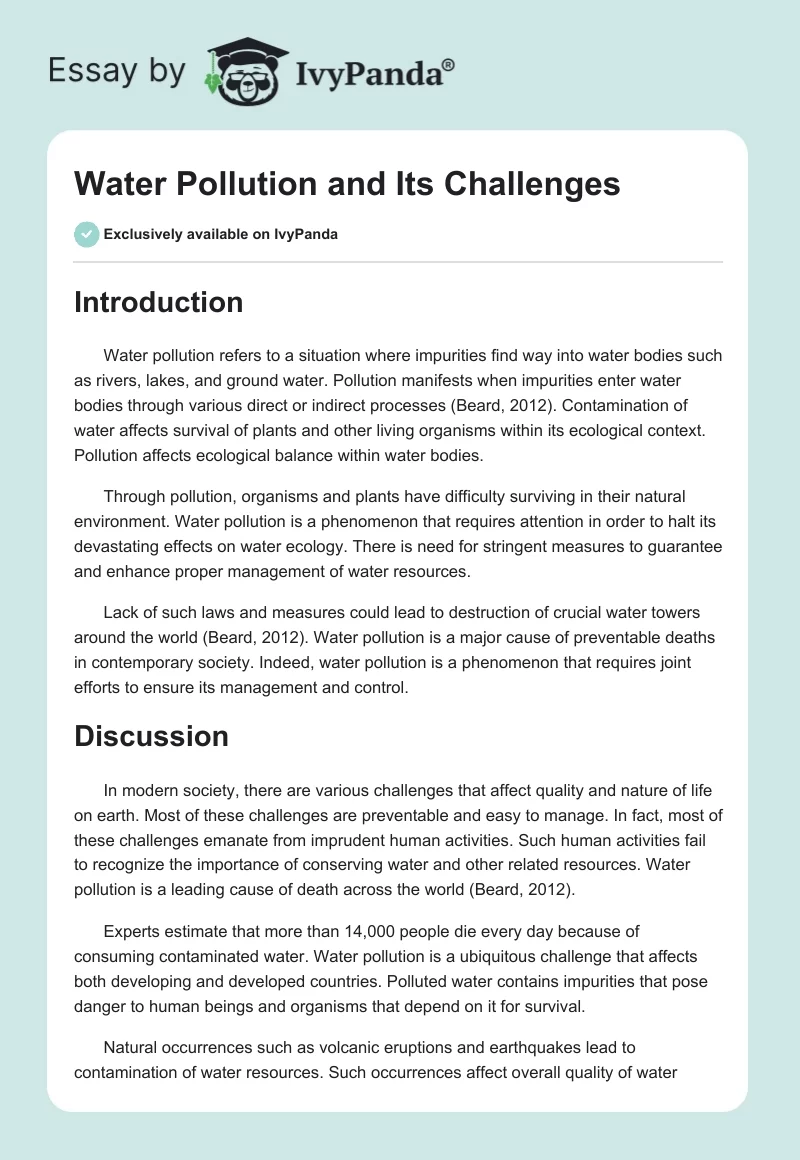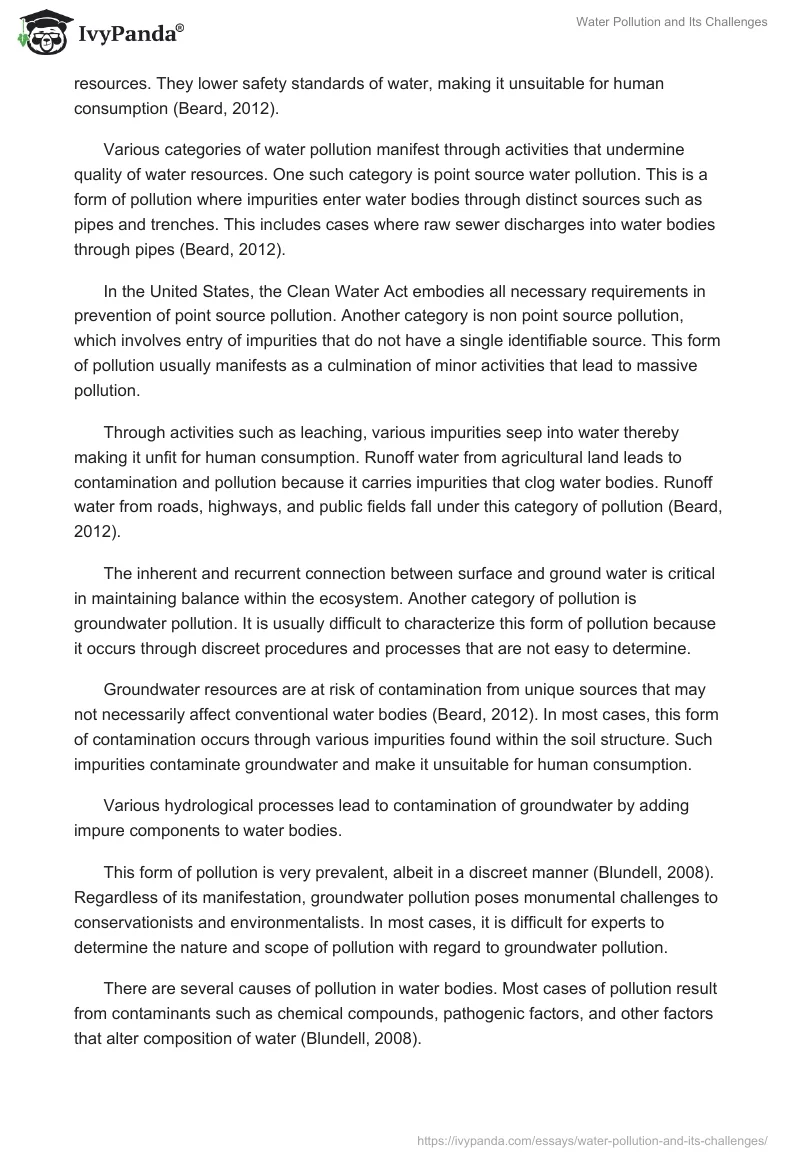Introduction
Water pollution refers to a situation where impurities find way into water bodies such as rivers, lakes, and ground water. Pollution manifests when impurities enter water bodies through various direct or indirect processes (Beard, 2012). Contamination of water affects survival of plants and other living organisms within its ecological context. Pollution affects ecological balance within water bodies.
Through pollution, organisms and plants have difficulty surviving in their natural environment. Water pollution is a phenomenon that requires attention in order to halt its devastating effects on water ecology. There is need for stringent measures to guarantee and enhance proper management of water resources.
Lack of such laws and measures could lead to destruction of crucial water towers around the world (Beard, 2012). Water pollution is a major cause of preventable deaths in contemporary society. Indeed, water pollution is a phenomenon that requires joint efforts to ensure its management and control.
Discussion
In modern society, there are various challenges that affect quality and nature of life on earth. Most of these challenges are preventable and easy to manage. In fact, most of these challenges emanate from imprudent human activities. Such human activities fail to recognize the importance of conserving water and other related resources. Water pollution is a leading cause of death across the world (Beard, 2012).
Experts estimate that more than 14,000 people die every day because of consuming contaminated water. Water pollution is a ubiquitous challenge that affects both developing and developed countries. Polluted water contains impurities that pose danger to human beings and organisms that depend on it for survival.
Natural occurrences such as volcanic eruptions and earthquakes lead to contamination of water resources. Such occurrences affect overall quality of water resources. They lower safety standards of water, making it unsuitable for human consumption (Beard, 2012).
Various categories of water pollution manifest through activities that undermine quality of water resources. One such category is point source water pollution. This is a form of pollution where impurities enter water bodies through distinct sources such as pipes and trenches. This includes cases where raw sewer discharges into water bodies through pipes (Beard, 2012).
In the United States, the Clean Water Act embodies all necessary requirements in prevention of point source pollution. Another category is non point source pollution, which involves entry of impurities that do not have a single identifiable source. This form of pollution usually manifests as a culmination of minor activities that lead to massive pollution.
Through activities such as leaching, various impurities seep into water thereby making it unfit for human consumption. Runoff water from agricultural land leads to contamination and pollution because it carries impurities that clog water bodies. Runoff water from roads, highways, and public fields fall under this category of pollution (Beard, 2012).
The inherent and recurrent connection between surface and ground water is critical in maintaining balance within the ecosystem. Another category of pollution is groundwater pollution. It is usually difficult to characterize this form of pollution because it occurs through discreet procedures and processes that are not easy to determine.
Groundwater resources are at risk of contamination from unique sources that may not necessarily affect conventional water bodies (Beard, 2012). In most cases, this form of contamination occurs through various impurities found within the soil structure. Such impurities contaminate groundwater and make it unsuitable for human consumption.
Various hydrological processes lead to contamination of groundwater by adding impure components to water bodies.
This form of pollution is very prevalent, albeit in a discreet manner (Blundell, 2008). Regardless of its manifestation, groundwater pollution poses monumental challenges to conservationists and environmentalists. In most cases, it is difficult for experts to determine the nature and scope of pollution with regard to groundwater pollution.
There are several causes of pollution in water bodies. Most cases of pollution result from contaminants such as chemical compounds, pathogenic factors, and other factors that alter composition of water (Blundell, 2008).
Most components of water are crucial but usually become contaminants if they exceed acceptable levels and standards. Such natural components have acceptable standards with regard to their ratio and composition in water. If they exceed such levels, they turn into contaminants (Lies, 2011). As a result, they pose danger to human and animal life.
Contamination of water leads to development of diseases that affects human beings. Most common water pollutants include organic and inorganic compounds that enter water bodies. Organic pollutants include detergents and wastes from food processing plants. Inorganic pollutants include various chemical compounds and fertilizers from agricultural fields (Lies, 2011).
Conclusion
Water pollution is a recurrent challenge for environmentalists and conservation experts. It presents challenges for humanity because of its dire effects on human health and wellness. In absence of strategic measures, water pollution threatens to bring more harm to the environment. Increase in water pollution could drastically reduce availability of clean water for human consumption.
This reality necessitates various control measures that seek to reverse current trends of water pollution in modern world. Various conservation organizations and agencies continue efforts to find a lasting and viable solution to water pollution. Indeed, water pollution is a phenomenon that requires joint efforts to ensure its management and control.
References
Beard, W. (2012). Environmental Conservation: Contemporary Approaches. Newyork: Cengage Learning.
Blundell, J. (2008). Implications of Environmental Degradation. London: Algora Publishing.
Lies, A. (2011). Effects of Water Pollution. Newyork: ABDO.


